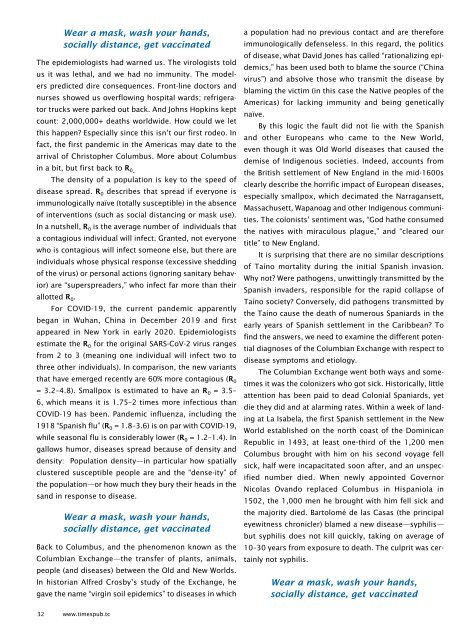Times of the Islands Spring 2021
Presents the "soul of the Turks & Caicos Islands" with in-depth features about local people, culture, history, environment, real estate, businesses, resorts, restaurants and activities.
Presents the "soul of the Turks & Caicos Islands" with in-depth features about local people, culture, history, environment, real estate, businesses, resorts, restaurants and activities.
Create successful ePaper yourself
Turn your PDF publications into a flip-book with our unique Google optimized e-Paper software.
Wear a mask, wash your hands,<br />
socially distance, get vaccinated<br />
The epidemiologists had warned us. The virologists told<br />
us it was lethal, and we had no immunity. The modelers<br />
predicted dire consequences. Front-line doctors and<br />
nurses showed us overflowing hospital wards; refrigerator<br />
trucks were parked out back. And Johns Hopkins kept<br />
count: 2,000,000+ deaths worldwide. How could we let<br />
this happen? Especially since this isn’t our first rodeo. In<br />
fact, <strong>the</strong> first pandemic in <strong>the</strong> Americas may date to <strong>the</strong><br />
arrival <strong>of</strong> Christopher Columbus. More about Columbus<br />
in a bit, but first back to R 0.<br />
The density <strong>of</strong> a population is key to <strong>the</strong> speed <strong>of</strong><br />
disease spread. R 0 describes that spread if everyone is<br />
immunologically naïve (totally susceptible) in <strong>the</strong> absence<br />
<strong>of</strong> interventions (such as social distancing or mask use).<br />
In a nutshell, R 0 is <strong>the</strong> average number <strong>of</strong> individuals that<br />
a contagious individual will infect. Granted, not everyone<br />
who is contagious will infect someone else, but <strong>the</strong>re are<br />
individuals whose physical response (excessive shedding<br />
<strong>of</strong> <strong>the</strong> virus) or personal actions (ignoring sanitary behavior)<br />
are “superspreaders,” who infect far more than <strong>the</strong>ir<br />
allotted R 0 .<br />
For COVID-19, <strong>the</strong> current pandemic apparently<br />
began in Wuhan, China in December 2019 and first<br />
appeared in New York in early 2020. Epidemiologists<br />
estimate <strong>the</strong> R 0 for <strong>the</strong> original SARS-CoV-2 virus ranges<br />
from 2 to 3 (meaning one individual will infect two to<br />
three o<strong>the</strong>r individuals). In comparison, <strong>the</strong> new variants<br />
that have emerged recently are 60% more contagious (R 0<br />
= 3.2–4.8). Smallpox is estimated to have an R 0 = 3.5–<br />
6, which means it is 1.75–2 times more infectious than<br />
COVID-19 has been. Pandemic influenza, including <strong>the</strong><br />
1918 “Spanish flu” (R 0 = 1.8–3.6) is on par with COVID-19,<br />
while seasonal flu is considerably lower (R 0 = 1.2–1.4). In<br />
gallows humor, diseases spread because <strong>of</strong> density and<br />
density: Population density—in particular how spatially<br />
clustered susceptible people are and <strong>the</strong> “dense-ity” <strong>of</strong><br />
<strong>the</strong> population—or how much <strong>the</strong>y bury <strong>the</strong>ir heads in <strong>the</strong><br />
sand in response to disease.<br />
Wear a mask, wash your hands,<br />
socially distance, get vaccinated<br />
Back to Columbus, and <strong>the</strong> phenomenon known as <strong>the</strong><br />
Columbian Exchange—<strong>the</strong> transfer <strong>of</strong> plants, animals,<br />
people (and diseases) between <strong>the</strong> Old and New Worlds.<br />
In historian Alfred Crosby’s study <strong>of</strong> <strong>the</strong> Exchange, he<br />
gave <strong>the</strong> name “virgin soil epidemics” to diseases in which<br />
a population had no previous contact and are <strong>the</strong>refore<br />
immunologically defenseless. In this regard, <strong>the</strong> politics<br />
<strong>of</strong> disease, what David Jones has called “rationalizing epidemics,”<br />
has been used both to blame <strong>the</strong> source (“China<br />
virus”) and absolve those who transmit <strong>the</strong> disease by<br />
blaming <strong>the</strong> victim (in this case <strong>the</strong> Native peoples <strong>of</strong> <strong>the</strong><br />
Americas) for lacking immunity and being genetically<br />
naïve.<br />
By this logic <strong>the</strong> fault did not lie with <strong>the</strong> Spanish<br />
and o<strong>the</strong>r Europeans who came to <strong>the</strong> New World,<br />
even though it was Old World diseases that caused <strong>the</strong><br />
demise <strong>of</strong> Indigenous societies. Indeed, accounts from<br />
<strong>the</strong> British settlement <strong>of</strong> New England in <strong>the</strong> mid-1600s<br />
clearly describe <strong>the</strong> horrific impact <strong>of</strong> European diseases,<br />
especially smallpox, which decimated <strong>the</strong> Narragansett,<br />
Massachusett, Wapanoag and o<strong>the</strong>r Indigenous communities.<br />
The colonists’ sentiment was, “God ha<strong>the</strong> consumed<br />
<strong>the</strong> natives with miraculous plague,” and “cleared our<br />
title” to New England.<br />
It is surprising that <strong>the</strong>re are no similar descriptions<br />
<strong>of</strong> Taíno mortality during <strong>the</strong> initial Spanish invasion.<br />
Why not? Were pathogens, unwittingly transmitted by <strong>the</strong><br />
Spanish invaders, responsible for <strong>the</strong> rapid collapse <strong>of</strong><br />
Taíno society? Conversely, did pathogens transmitted by<br />
<strong>the</strong> Taíno cause <strong>the</strong> death <strong>of</strong> numerous Spaniards in <strong>the</strong><br />
early years <strong>of</strong> Spanish settlement in <strong>the</strong> Caribbean? To<br />
find <strong>the</strong> answers, we need to examine <strong>the</strong> different potential<br />
diagnoses <strong>of</strong> <strong>the</strong> Columbian Exchange with respect to<br />
disease symptoms and etiology.<br />
The Columbian Exchange went both ways and sometimes<br />
it was <strong>the</strong> colonizers who got sick. Historically, little<br />
attention has been paid to dead Colonial Spaniards, yet<br />
die <strong>the</strong>y did and at alarming rates. Within a week <strong>of</strong> landing<br />
at La Isabela, <strong>the</strong> first Spanish settlement in <strong>the</strong> New<br />
World established on <strong>the</strong> north coast <strong>of</strong> <strong>the</strong> Dominican<br />
Republic in 1493, at least one-third <strong>of</strong> <strong>the</strong> 1,200 men<br />
Columbus brought with him on his second voyage fell<br />
sick, half were incapacitated soon after, and an unspecified<br />
number died. When newly appointed Governor<br />
Nicolas Ovando replaced Columbus in Hispaniola in<br />
1502, <strong>the</strong> 1,000 men he brought with him fell sick and<br />
<strong>the</strong> majority died. Bartolomé de las Casas (<strong>the</strong> principal<br />
eyewitness chronicler) blamed a new disease—syphilis—<br />
but syphilis does not kill quickly, taking on average <strong>of</strong><br />
10–30 years from exposure to death. The culprit was certainly<br />
not syphilis.<br />
Wear a mask, wash your hands,<br />
socially distance, get vaccinated<br />
32 www.timespub.tc

















